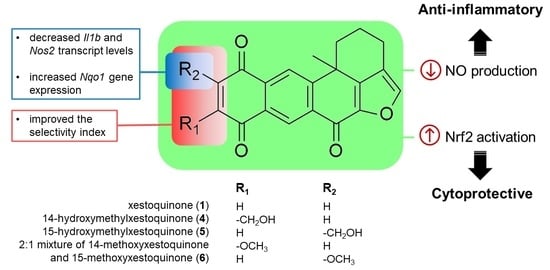Anti-Inflammatory Activity of Monosubstituted Xestoquinone Analogues from the Marine Sponge Neopetrosia compacta
Abstract
:1. Introduction
2. Materials and Methods
2.1. General Experimental Procedures
2.2. Extraction of Sponge Samples
2.3. Nitric Oxide Production Assay
2.4. Tetrazolium-Based Cell Viability Assay
2.5. Bioactivity-Guided Purification of N. compacta (Lala1F)
2.6. RNA Extraction, Quantitative RT-PCR, and Differential Expression Analysis
2.7. Direct Antioxidant Activity Assay
2.8. Nrf2-ARE Activation Luciferase Reporter Assay
3. Results
3.1. Screening for Anti-Inflammatory Activity of Sponge Crude Extracts
3.2. Bioactivity-Guided Purification of N. compacta Lala1F
3.3. Biological Activity and Structure-Activity Relationship (SAR) Studies
3.4. Direct Antioxidant Activity of 1–6
3.5. Nrf2 Activation in Nrf2-Luciferase Reporter MCF7 Cells
3.6. Differential Expression of Pro-Inflammatory (Nos2 and Il1b) and Cytoprotective Antioxidant (Nqo1) Genes
4. Discussion
5. Conclusions
Supplementary Materials
Author Contributions
Funding
Institutional Review Board Statement
Informed Consent Statement
Data Availability Statement
Acknowledgments
Conflicts of Interest
References
- Carroll, A.R.; Copp, B.R.; Davis, R.A.; Keyzers, R.A.; Prinsep, M.R. Marine Natural Products. Nat. Prod. Rep. 2021, 38, 362–413. [Google Scholar] [CrossRef] [PubMed]
- Hu, Y.; Chen, J.; Hu, G.; Yu, J.; Zhu, X.; Lin, Y.; Chen, S.; Yuan, J. Statistical Research on the Bioactivity of New Marine Natural Products Discovered during the 28 Years from 1985 to 2012. Mar. Drugs 2015, 13, 202–221. [Google Scholar] [CrossRef]
- Mehbub, M.F.; Lei, J.; Franco, C.; Zhang, W. Marine Sponge Derived Natural Products between 2001 and 2010: Trends and Opportunities for Discovery of Bioactives. Mar. Drugs 2014, 12, 4539–4577. [Google Scholar] [CrossRef] [PubMed] [Green Version]
- Calcabrini, C.; Catanzaro, E.; Bishayee, A.; Turrini, E.; Fimognari, C. Marine Sponge Natural Products with Anticancer Potential: An Updated Review. Mar. Drugs 2017, 15, 310. [Google Scholar] [CrossRef] [Green Version]
- Anjum, K.; Abbas, S.Q.; Shah, S.A.A.; Akhter, N.; Batool, S.; ul Hassan, S.S. Marine Sponges as a Drug Treasure. Biomol. Ther. 2016, 24, 347–362. [Google Scholar] [CrossRef] [PubMed] [Green Version]
- Pawlik, J.R.; McMurray, S.E. The Emerging Ecological and Biogeochemical Importance of Sponges on Coral Reefs. Annu. Rev. Mar. Sci. 2020, 12, 315–337. [Google Scholar] [CrossRef] [PubMed] [Green Version]
- Cheung, R.C.F.; Ng, T.B.; Wong, J.H.; Chen, Y.; Chan, W.Y. Marine Natural Products with Anti-Inflammatory Activity. Appl. Microbiol. Biotechnol. 2016, 100, 1645–1666. [Google Scholar] [CrossRef] [PubMed]
- Furman, D.; Campisi, J.; Verdin, E.; Carrera-Bastos, P.; Targ, S.; Franceschi, C.; Ferrucci, L.; Gilroy, D.W.; Fasano, A.; Miller, G.W.; et al. Chronic Inflammation in the Etiology of Disease across the Life Span. Nat. Med. 2019, 25, 1822–1832. [Google Scholar] [CrossRef] [PubMed]
- Pahwa, R.; Goyal, A.; Bansal, P.; Jialal, I. Chronic Inflammation; StatPearls Publishing: Treasure Island, FL, USA, 2021. [Google Scholar]
- Mayer, A.; Rodríguez, A.; Taglialatela-Scafati, O.; Fusetani, N. Marine Pharmacology in 2009–2011: Marine Compounds with Antibacterial, Antidiabetic, Antifungal, Anti-Inflammatory, Antiprotozoal, Antituberculosis, and Antiviral Activities; Affecting the Immune and Nervous Systems, and Other Miscellaneous Mechanisms of Action. Mar. Drugs 2013, 11, 2510–2573. [Google Scholar] [CrossRef] [PubMed]
- Mayer, A.; Rodríguez, A.; Taglialatela-Scafati, O.; Fusetani, N. Marine Pharmacology in 2012–2013: Marine Compounds with Antibacterial, Antidiabetic, Antifungal, Anti-Inflammatory, Antiprotozoal, Antituberculosis, and Antiviral Activities; Affecting the Immune and Nervous Systems, and Other Miscellaneous Mechanisms of Action. Mar. Drugs 2017, 15, 273. [Google Scholar] [CrossRef]
- Mayer, A.M.S.; Guerrero, A.J.; Rodríguez, A.D.; Taglialatela-Scafati, O.; Nakamura, F.; Fusetani, N. Marine Pharmacology in 2014–2015: Marine Compounds with Antibacterial, Antidiabetic, Antifungal, Anti-Inflammatory, Antiprotozoal, Antituberculosis, Antiviral, and Anthelmintic Activities; Affecting the Immune and Nervous Systems, and Other Miscellaneous Mechanisms of Action. Mar. Drugs 2020, 18, 5. [Google Scholar] [CrossRef] [Green Version]
- Mayer, A.M.S.; Guerrero, A.J.; Rodríguez, A.D.; Taglialatela-Scafati, O.; Nakamura, F.; Fusetani, N. Marine Pharmacology in 2016–2017: Marine Compounds with Antibacterial, Antidiabetic, Antifungal, Anti-Inflammatory, Antiprotozoal, Antituberculosis and Antiviral Activities; Affecting the Immune and Nervous Systems, and Other Miscellaneous Mechanisms of Action. Mar. Drugs 2021, 19, 49. [Google Scholar] [CrossRef] [PubMed]
- Nakao, Y.; Fusetani, N. Marine Invertebrates: Sponges. Compr. Nat. Prod. II Chem. Biol. 2010, 2, 327–362. [Google Scholar] [CrossRef]
- Keyzers, R.A.; Davies-Coleman, M.T. Anti-Inflammatory Metabolites from Marine Sponges. Chem. Soc. Rev. 2005, 34, 355–365. [Google Scholar] [CrossRef] [PubMed]
- Ratnayake, R.; Liu, Y.; Paul, V.J.; Luesch, H. Cultivated Sea Lettuce Is a Multiorgan Protector from Oxidative and Inflammatory Stress by Enhancing the Endogenous Antioxidant Defense System. Cancer Prev. Res. 2013, 6, 989–999. [Google Scholar] [CrossRef] [PubMed] [Green Version]
- Posadas, N.; Baquiran, J.I.P.; Nada, M.A.L.; Kelly, M.; Conaco, C. Microbiome Diversity and Host Immune Functions Influence Survivorship of Sponge Holobionts under Future Ocean Conditions. ISME J. 2021, 16, 58–67. [Google Scholar] [CrossRef] [PubMed]
- Laurent, D.; Jullian, V.; Parenty, A.; Knibiehler, M.; Dorin, D.; Schmitt, S.; Lozach, O.; Lebouvier, N.; Frostin, M.; Alby, F.; et al. Antimalarial Potential of Xestoquinone, a Protein Kinase Inhibitor Isolated from a Vanuatu Marine Sponge Xestospongia sp. Bioorg. Med. Chem. 2006, 14, 4477–4482. [Google Scholar] [CrossRef] [PubMed]
- Nakamura, H.; Kobayashi, J.; Kobayashi, M.; Ohizumi, Y.; Hirata, Y. Xestoquinone, a Novel Cardiotonic Marine Natural Product Isolated from the Okinawan Sea Sponge Xestospongia sapra. Chem. Lett. 1985, 14, 713–716. [Google Scholar] [CrossRef] [Green Version]
- Concepcion, G.P.; Foderaro, T.A.; Eldredge, G.S.; Lobkovsky, E.; Clardy, J.; Barrows, L.R.; Ireland, C.M. Topoisomerase II-Mediated DNA Cleavage by Adocia- and Xestoquinones from the Philippine Sponge Xestospongia sp. J. Med. Chem. 1995, 38, 4503–4507. [Google Scholar] [CrossRef] [PubMed]
- Schmitz, F.J.; Bloor, S.J. Xesto- and Halenaquinone Derivatives from a Sponge, Adocia sp., from Truk Lagoon. J. Org. Chem. 1988, 53, 3922–3925. [Google Scholar] [CrossRef]
- Du, L.; Mahdi, F.; Datta, S.; Jekabsons, M.B.; Zhou, Y.-D.; Nagle, D.G. Structures and Mechanisms of Antitumor Agents: Xestoquinones Uncouple Cellular Respiration and Disrupt HIF Signaling in Human Breast Tumor Cells. J. Nat. Prod. 2012, 75, 1553–1559. [Google Scholar] [CrossRef] [PubMed] [Green Version]
- Sutherland, H.S.; Higgs, K.C.; Taylor, N.J.; Rodrigo, R. Isobenzofurans and Ortho-Benzoquinone Monoketals in Syntheses of Xestoquinone and its 9- and 10-Methoxy Derivatives. Tetrahedron 2001, 57, 309–317. [Google Scholar] [CrossRef]
- Bousquet, M.S.; Ratnayake, R.; Pope, J.L.; Chen, Q.Y.; Zhu, F.; Chen, S.; Carney, T.J.; Gharaibeh, R.Z.; Jobin, C.; Paul, V.J.; et al. Seaweed Natural Products Modify the Host Inflammatory Response via Nrf2 Signaling and Alter Colon Microbiota Composition and Gene Expression. Free Radic. Biol. Med. 2020, 146, 306–323. [Google Scholar] [CrossRef] [PubMed]
- Wang, R.; Paul, V.J.; Luesch, H. Seaweed Extracts and Unsaturated Fatty Acid Constituents from the Green Alga Ulva lactuca as Activators of the Cytoprotective Nrf2–ARE Pathway. Free Radic. Biol. Med. 2013, 57, 141–153. [Google Scholar] [CrossRef] [PubMed] [Green Version]
- Mascuch, S.J.; Boudreau, P.D.; Carland, T.M.; Pierce, N.T.; Olson, J.; Hensler, M.E.; Choi, H.; Campanale, J.; Hamdoun, A.; Nizet, V.; et al. Marine Natural Product Honaucin A Attenuates Inflammation by Activating the Nrf2-ARE Pathway. J. Nat. Prod. 2018, 81, 506–514. [Google Scholar] [CrossRef] [PubMed]
- He, F.; Ru, X.; Wen, T. NRF2, a Transcription Factor for Stress Response and Beyond. Int. J. Mol. Sci. 2020, 21, 4777. [Google Scholar] [CrossRef]
- Zhang, D.D.; Chapman, E. The Role of Natural Products in Revealing NRF2 Function. Nat. Prod. Rep. 2020, 37, 797–826. [Google Scholar] [CrossRef]
- Cao, S.; Foster, C.; Brisson, M.; Lazo, J.S.; Kingston, D.G.I. Halenaquinone and Xestoquinone Derivatives, Inhibitors of Cdc25B Phosphatase from a Xestospongia sp. Bioorg. Med. Chem. 2005, 13, 999–1003. [Google Scholar] [CrossRef]
- He, F.; Mai, L.; Longeon, A.; Copp, B.; Loaëc, N.; Bescond, A.; Meijer, L.; Bourguet-Kondracki, M.-L. Novel Adociaquinone Derivatives from the Indonesian Sponge Xestospongia sp. Mar. Drugs 2015, 13, 2617–2628. [Google Scholar] [CrossRef] [Green Version]
- McKee, T.C.; Rabe, D.; Bokesch, H.R.; Grkovic, T.; Whitson, E.L.; Diyabalanage, T.; Van Wyk, A.W.W.; Marcum, S.R.; Gardella, R.S.; Gustafson, K.R.; et al. Inhibition of Hypoxia Inducible Factor-2 Transcription: Isolation of Active Modulators from Marine Sponges. J. Nat. Prod. 2012, 75, 1632–1636. [Google Scholar] [CrossRef] [PubMed] [Green Version]
- Zhou, X.; Xu, T.; Yang, X.-W.; Huang, R.; Yang, B.; Tang, L.; Liu, Y. Chemical and Biological Aspects of Marine Sponges of the Genus Xestospongia. Chem. Biodivers. 2010, 7, 2201–2227. [Google Scholar] [CrossRef] [PubMed]
- Huang, Y.; Li, W.; Su, Z.; Kong, A.N.T. The Complexity of the Nrf2 Pathway: Beyond the Antioxidant Response. J. Nutr. Biochem. 2015, 26, 1401–1413. [Google Scholar] [CrossRef] [PubMed]
- Mohan, S.; Gupta, D. Crosstalk of Toll-like Receptors Signaling and Nrf2 Pathway for Regulation of Inflammation. Biomed. Pharmacother. 2018, 108, 1866–1878. [Google Scholar] [CrossRef]
- Satoh, T.; Lipton, S. Recent Advances in Understanding Nrf2 as a Druggable Target: Development of pro-Electrophilic and Non-Covalent NRF2 Activators to Overcome Systemic Side Effects of Electrophilic Drugs like Dimethyl Fumarate. F1000Research 2017, 6, 2138. [Google Scholar] [CrossRef] [PubMed] [Green Version]
- Unoki, T.; Akiyama, M.; Kumagai, Y. Nrf2 Activation and Its Coordination with the Protective Defense Systems in Response to Electrophilic Stress. Int. J. Mol. Sci. 2020, 21, 545. [Google Scholar] [CrossRef] [PubMed] [Green Version]
- Nakamura, M.; Kakuda, T.; Oba, Y.; Ojika, M.; Nakamura, H. Synthesis of Biotinylated Xestoquinone That Retains Inhibitory Activity against Ca2+ ATPase of Skeletal Muscle Myosin. Bioorg. Med. Chem. 2003, 11, 3077–3082. [Google Scholar] [CrossRef]
- Sakamoto, H.; Furukawa, K.-I.; Matsunaga, K.; Nakamura, H.; Ohizumi, Y. Xestoquinone Activates Skeletal Muscle Actomyosin ATPase by Modification of the Specific Sulfhydryl Group in the Myosin Head Probably Distinct from Sulfhydryl Groups SH1 and SH2. Biochemistry 1995, 34, 12570–12575. [Google Scholar] [CrossRef] [PubMed]
- Wang, J.; Bourguet-Kondracki, M.-L.; Longeon, A.; Dubois, J.; Valentin, A.; Copp, B.R. Chemical and Biological Explorations of the Electrophilic Reactivity of the Bioactive Marine Natural Product Halenaquinone with Biomimetic Nucleophiles. Bioorg. Med. Chem. Lett. 2011, 21, 1261–1264. [Google Scholar] [CrossRef] [PubMed]
- Ito, M.; Hirata, Y.; Nakamura, H.; Ohizumi, Y. Xestoquinone, Isolated from Sea Sponge, Causes Ca2+ Release through Sulfhydryl Modification from Skeletal Muscle Sarcoplasmic Reticulum. J. Pharmacol. Exp. Ther. 1999, 291, 976–981. [Google Scholar]
- Mi, Z.; Rapisarda, A.; Taylor, L.; Brooks, A.; Creighton-Gutteridge, M.; Melillo, G.; Varesio, L. Synergystic Induction of HIF-1α Transcriptional Activity by Hypoxia and Lipopolysaccharide in Macrophages. Cell Cycle 2008, 7, 232–241. [Google Scholar] [CrossRef] [Green Version]
- Kiani, A.A.; Elyasi, H.; Ghoreyshi, S.; Nouri, N.; Safarzadeh, A.; Nafari, A. Study on Hypoxia-Inducible Factor and Its Roles in Immune System. Immunol. Med. 2021, 44, 223–236. [Google Scholar] [CrossRef] [PubMed]
- Yeh, C.-H.; Cho, W.; So, E.C.; Chu, C.-C.; Lin, M.-C.; Wang, J.-J.; Hsing, C.-H. Propofol Inhibits Lipopolysaccharide-Induced Lung Epithelial Cell Injury by Reducing Hypoxia-Inducible Factor-1α Expression. Br. J. Anaesth. 2011, 106, 590–599. [Google Scholar] [CrossRef] [PubMed] [Green Version]
- Oh, Y.T.; Lee, J.Y.; Yoon, H.; Lee, E.H.; Baik, H.H.; Kim, S.S.; Ha, J.; Yoon, K.-S.; Choe, W.; Kang, I. Lipopolysaccharide Induces Hypoxia-Inducible Factor-1 alpha mRNA Expression and Activation via NADPH Oxidase and Sp1-Dependent Pathway in BV2 Murine Microglial Cells. Neurosci. Lett. 2008, 431, 155–160. [Google Scholar] [CrossRef] [PubMed]
- Poyton, R.; Hendrickson, M. Crosstalk between Nitric Oxide and Hypoxia-Inducible Factor Signaling Pathways: An Update. Res. Rep. Biochem. 2015, 5, 147–161. [Google Scholar] [CrossRef] [Green Version]
- Dewitz, C.; McEachern, E.; Shin, S.; Akong, K.; Nagle, D.G.; Broide, D.H.; Akuthota, P.; Crotty Alexander, L.E. Hypoxia-Inducible Factor-1α Inhibition Modulates Airway Hyperresponsiveness and Nitric Oxide Levels in a BALB/c Mouse Model of Asthma. Clin. Immunol. 2017, 176, 94–99. [Google Scholar] [CrossRef] [PubMed]
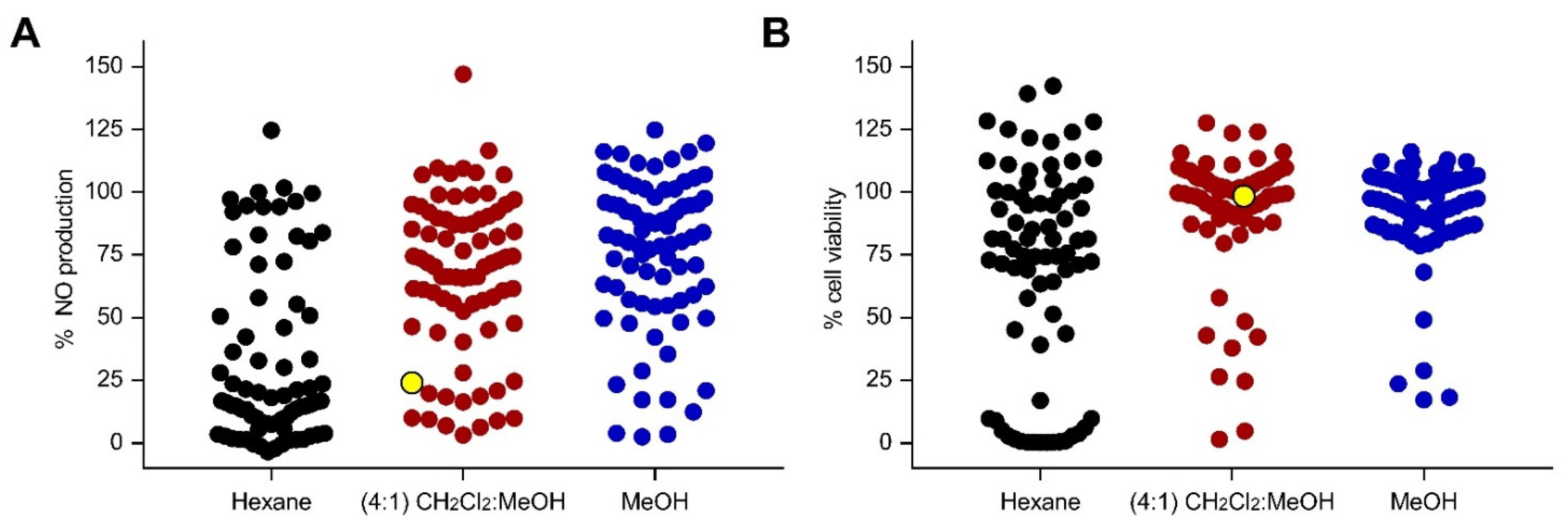
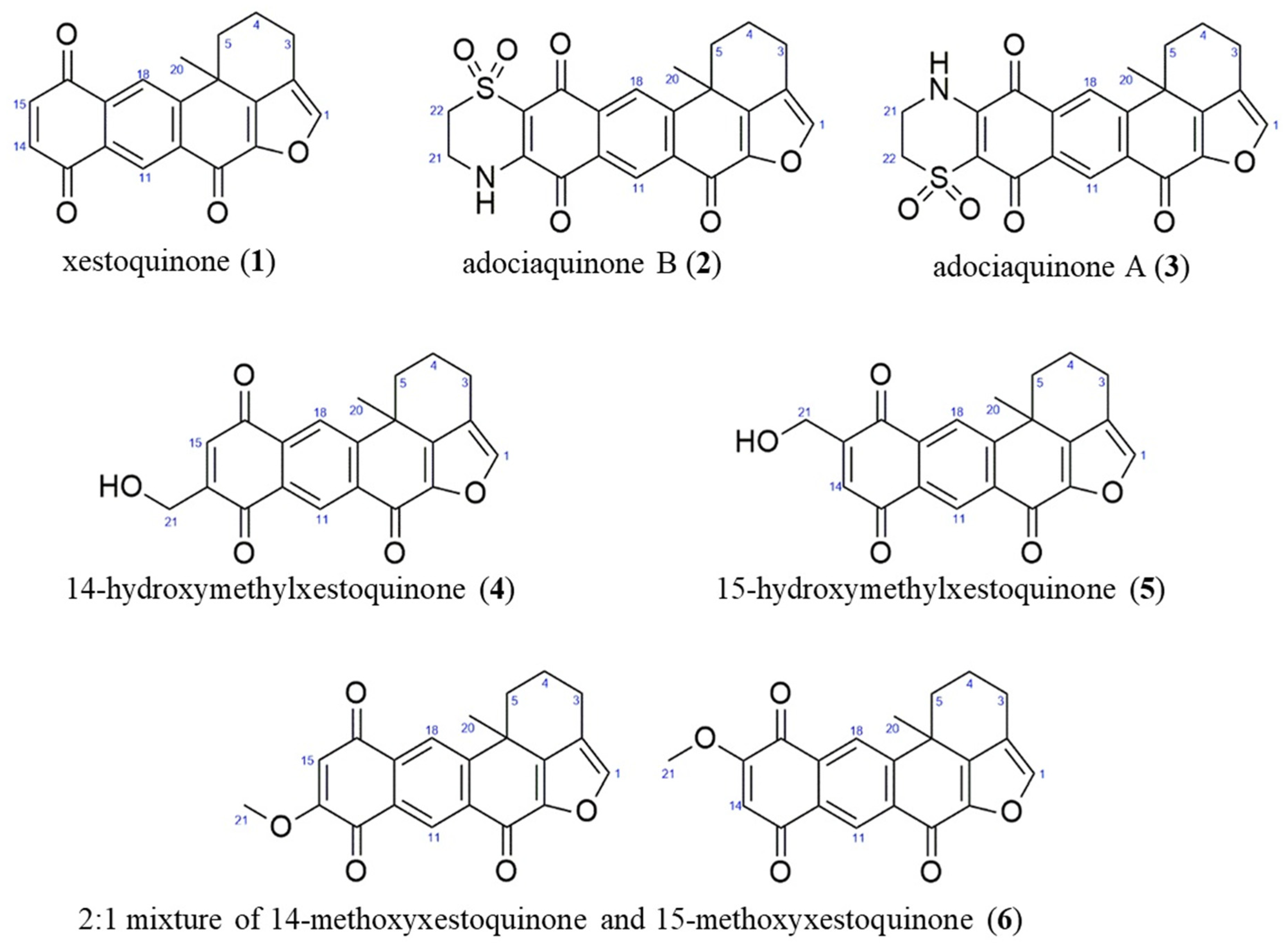
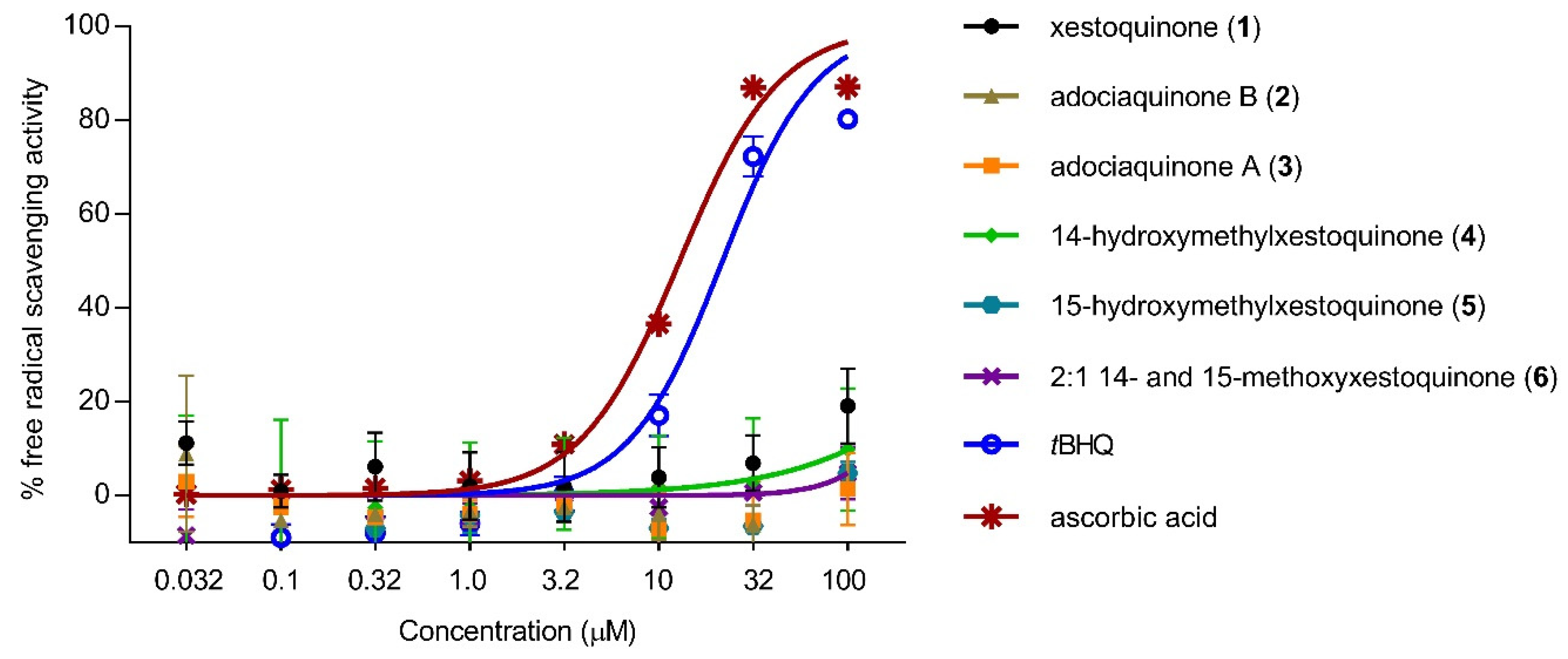
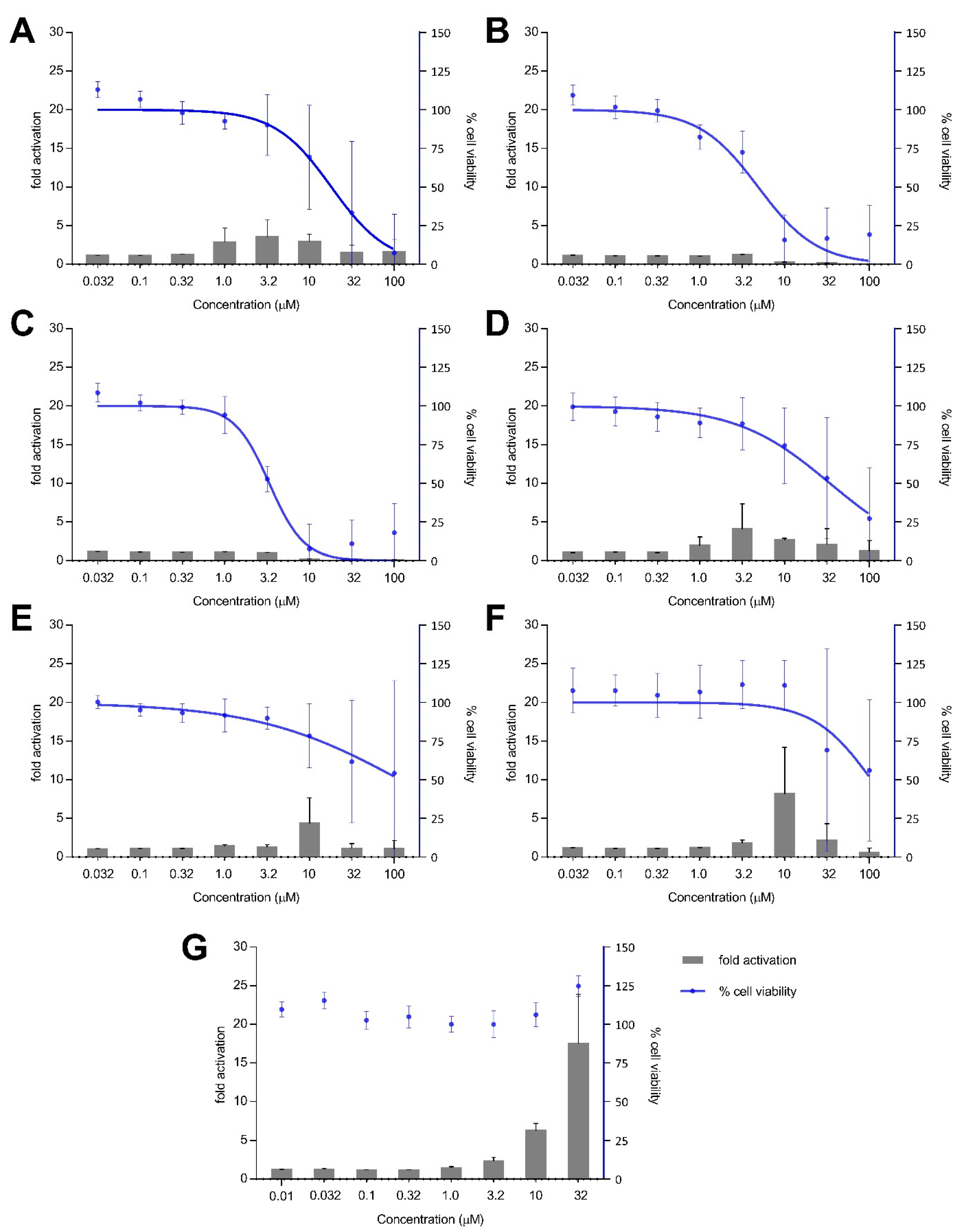
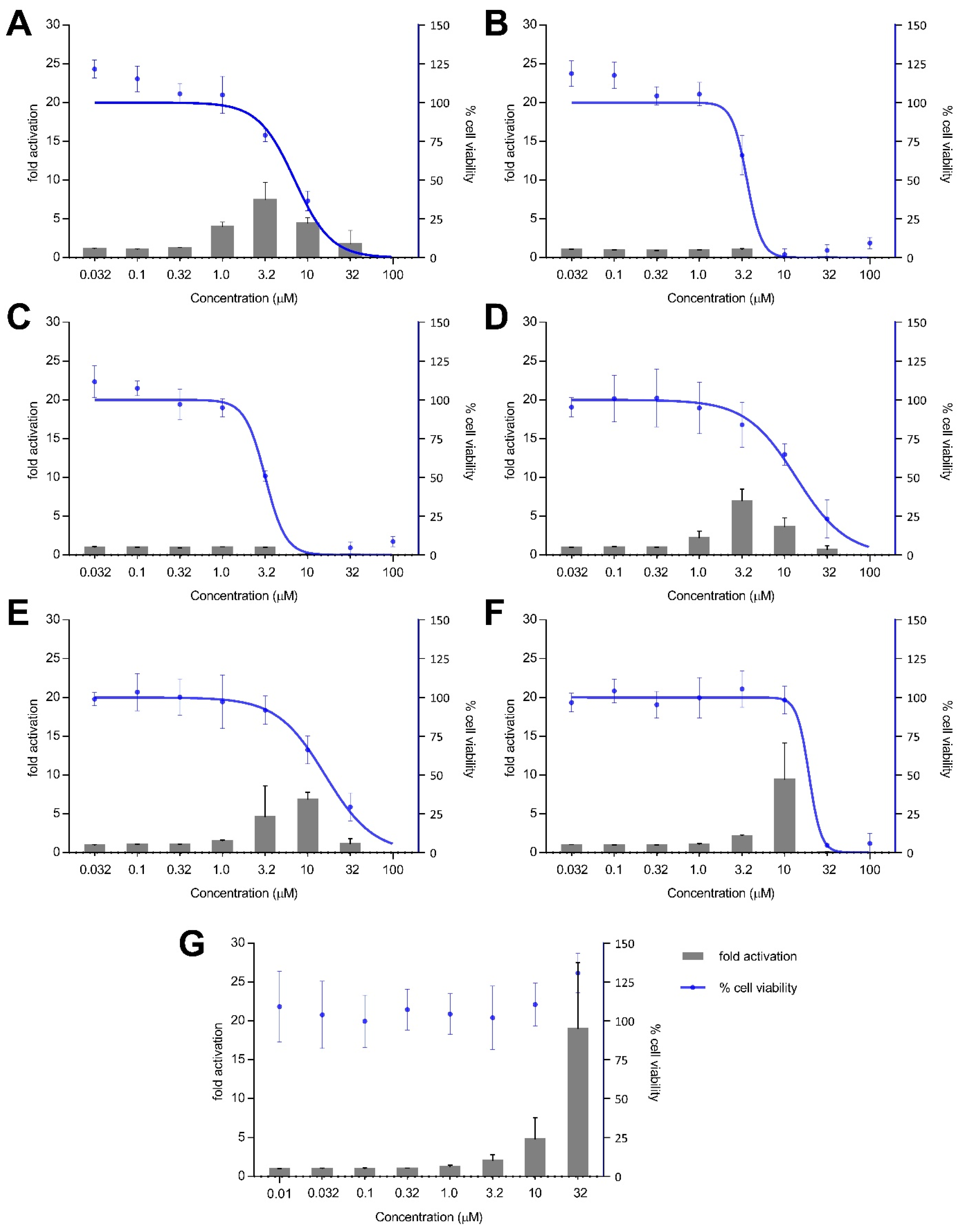
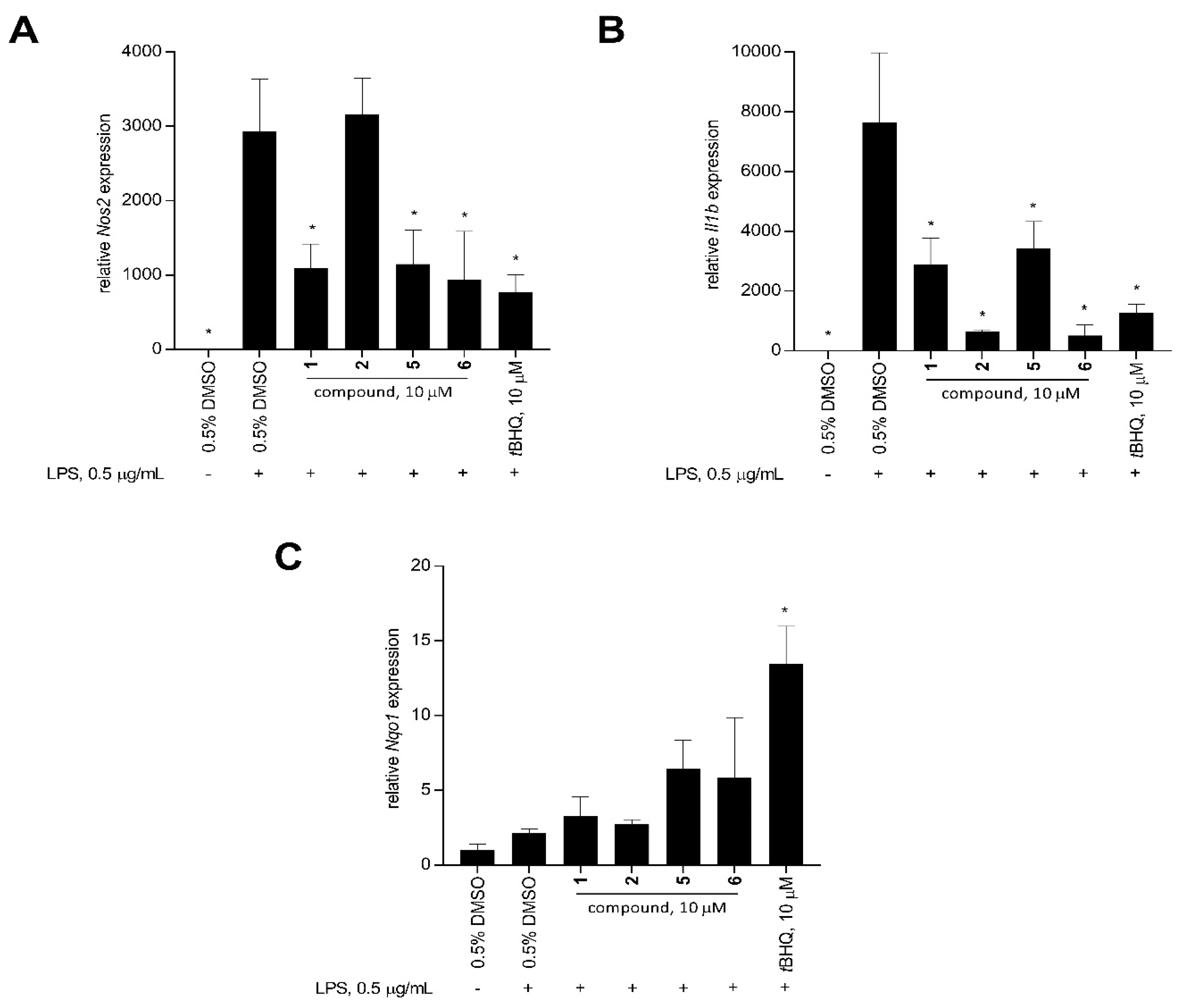
| Compound | Compound Pre-Treatment + LPS a | LPS Pre-Treatment + Compound b | ||
|---|---|---|---|---|
| NO Production (μM) | Cell Viability (μM) | NO Production (μM) | Cell Viability (μM) | |
| xestoquinone (1) | 1.2 ± 0.10 | 6.0 ± 3.2 | 0.99 | 4.9 |
| adociaquinone B (2) | 1.9 ± 0.72 | 5.3 ± 2.0 | 1.5 | 4.2 |
| adociaquinone A (3) | 2.1 ± 0.17 c | 6.4 ± 1.2 | 1.5 | 5.9 |
| 14-hydroxymethylxestoquinone (4) | 2.5 ± 0.39 c | 16 ± 0.68 | 1.8 | 27 |
| 15-hydroxymethylxestoquinone (5) | 4.0 ± 2.4 c | >32 d | 4.7 | >32 |
| 2:1 mixture of 14-methoxyxestoquinone and 15-methoxyxestoquinone (6) | 1.4 ± 0.56 c | 22 ± 8.5 d | 1.6 | 17 |
| tBHQ | 1.2 ± 0.23 | >100 | 0.42 | >100 |
| dexamethasone | >0.032 | >100 | >0.032 | >100 |
Publisher’s Note: MDPI stays neutral with regard to jurisdictional claims in published maps and institutional affiliations. |
© 2022 by the authors. Licensee MDPI, Basel, Switzerland. This article is an open access article distributed under the terms and conditions of the Creative Commons Attribution (CC BY) license (https://creativecommons.org/licenses/by/4.0/).
Share and Cite
Susana, S.R.; Salvador-Reyes, L.A. Anti-Inflammatory Activity of Monosubstituted Xestoquinone Analogues from the Marine Sponge Neopetrosia compacta. Antioxidants 2022, 11, 607. https://doi.org/10.3390/antiox11040607
Susana SR, Salvador-Reyes LA. Anti-Inflammatory Activity of Monosubstituted Xestoquinone Analogues from the Marine Sponge Neopetrosia compacta. Antioxidants. 2022; 11(4):607. https://doi.org/10.3390/antiox11040607
Chicago/Turabian StyleSusana, Shalice R., and Lilibeth A. Salvador-Reyes. 2022. "Anti-Inflammatory Activity of Monosubstituted Xestoquinone Analogues from the Marine Sponge Neopetrosia compacta" Antioxidants 11, no. 4: 607. https://doi.org/10.3390/antiox11040607
APA StyleSusana, S. R., & Salvador-Reyes, L. A. (2022). Anti-Inflammatory Activity of Monosubstituted Xestoquinone Analogues from the Marine Sponge Neopetrosia compacta. Antioxidants, 11(4), 607. https://doi.org/10.3390/antiox11040607






